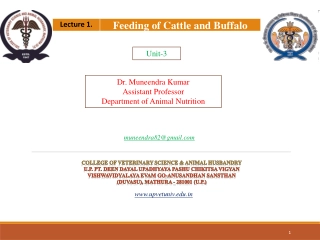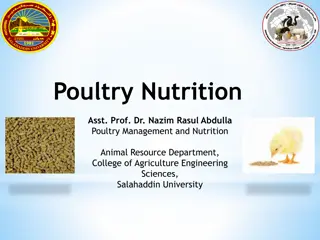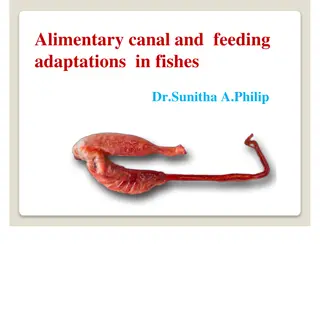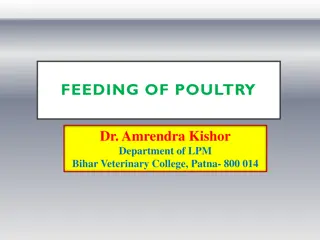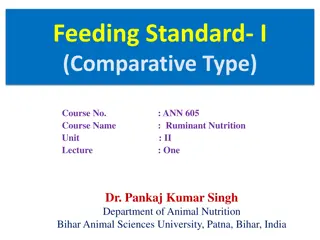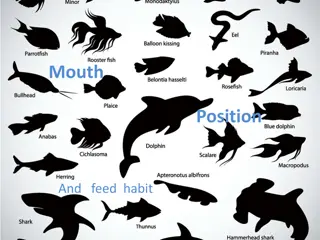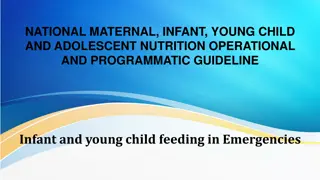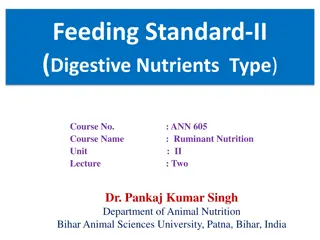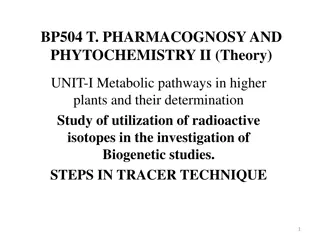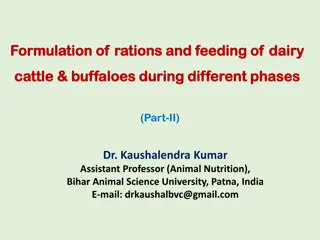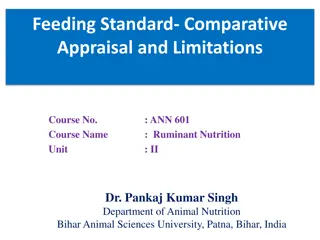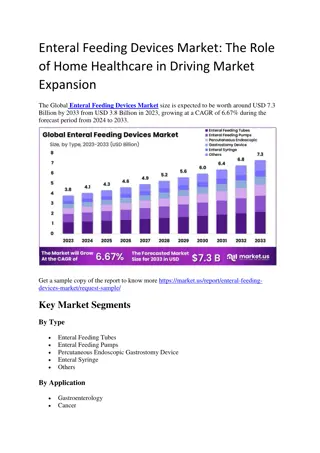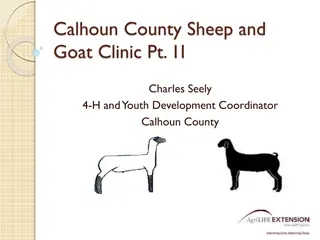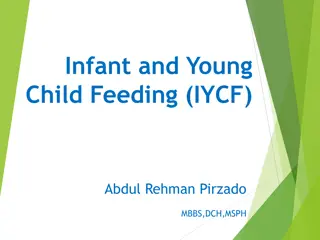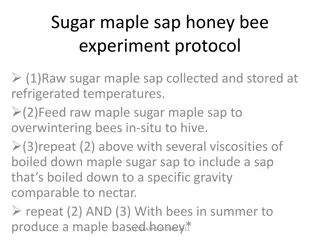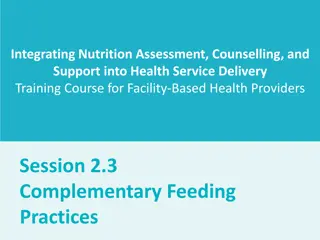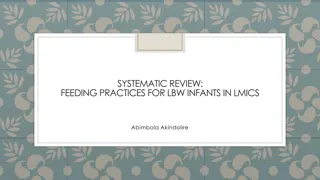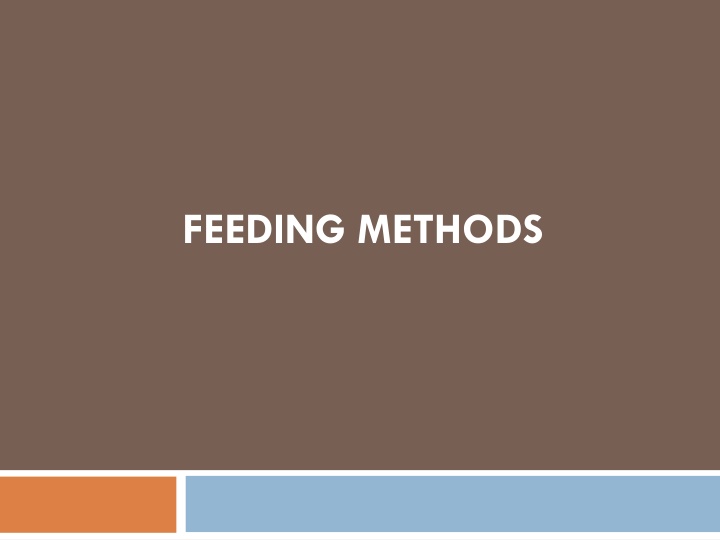
Feeding Dairy Cows and Calves - Nutritional Guidelines and Best Practices
Explore feeding methods and requirements for dairy cows and calves, including nutritional values, feed items, energy needs, weaning practices, and growth milestones. Learn about feeding heifers, colostrum intake for calves, milk replacer usage, weaning strategies, and calf starter recommendations. Enhance your knowledge of animal nutrition and feeding strategies for optimal health and productivity in dairy farming.
Download Presentation

Please find below an Image/Link to download the presentation.
The content on the website is provided AS IS for your information and personal use only. It may not be sold, licensed, or shared on other websites without obtaining consent from the author. If you encounter any issues during the download, it is possible that the publisher has removed the file from their server.
You are allowed to download the files provided on this website for personal or commercial use, subject to the condition that they are used lawfully. All files are the property of their respective owners.
The content on the website is provided AS IS for your information and personal use only. It may not be sold, licensed, or shared on other websites without obtaining consent from the author.
E N D
Presentation Transcript
Introduction Things to know The nutritional value of feeds Animal requirements of nutrients Nutrients intake Availability of feed ingredients Supply Demand
Feeding Dairy cows A minimum of ~ 17% CF (changes relative to production) At least 5-6 feed items No undesired odor/color/taste associated w/ feeds Primiparous cows (1st lactation) : + 20% maintenance energy (ME) Multiparous cows (2nd lactation) : + 10% maintenance energy (ME) Multiparous cows (3rd lactation): mature
Heifers b/w weaning & age at 1st calving (~24 month): 8- 10 times BW gain Physiologically, rumen performs near complete at 4 month old but not in terms of its capacity: ~ 12-14 month ~45% mature BW at 1st breeding Last trimester: ~ 40% fetus BW gain 20% addition of energy on top (if 1st calving)
Feeding calves Dip naval ~ 2 liters colostrum at birth ~ 2 liters within the next 12-24 h Continue for 3 d It works!!!! Passive immunity ~ 65% of operations do so by bucket or bottle
Cont. Sometimes, it is more beneficial to use milk replacer More saving when higher milk price Water at day 3 Cocccidiostat in milk replacer
Weaning- traditional Day 4 to weaning: Milk replacer (~13% DM) at 10% BW/d At least 20% CP & 15% fat Twice/d Calf starter (commercially available) Free choice 16-20% CP Not much forage
Cont. Wean ~ 5-6 wk: when eating 0.5-0.7 kg starter/d for at least 3 consecutive d Milk to 50% during 1st wk and totally in 2nd wk Leave in individual pen/calf starter for 1-2 wk before moving to group pen/grain mix ~ 37% wean at wk 8; ~9% at wk 7; ~ 18% at wk 6; ~ 28% wean after wk 8
Calf starter intake and growth (Eastridge and Weiss; 2005) Age, day Intake, lb/d Age, day BW, lb 7 0.25 3 95 14 0.35 28 127 21 0.7 36 148 28 1.2 57 170 35 1.9 72 195 42 3 86 230 49 3.5 96 265
Weaning- accelerated growth At day 4, milk replacer 14-17% DM (more solids) 26-28% CP (more protein); same fat content ~ 2-2.2 liters twice/d for wk 1 2.7-3.6 liters twice/d for wk 2 to wk 4-5 2.7-3.6 liters once/d for 1 wk at weaning At day 4, calf starter 20-22% CP (more protein) Intake is ~ half vs. traditional weaning
Cont. Wean at 6-7 wk; when eating ~ 1 kg starter/d for 3 consecutive d Continue high quality calf starter to 10-12 wk age Offer forage when eating 2.2 to 2.7 kg starter/d
Comparison between Accelerated vs. Traditional Advantages Disadvantages Shorter time to breeding (20-30 d sooner) Increased feed costs More loose feces Increased gain efficiency Delayed rumen development Increased milk yield ?? Intensive management Health & immune system ???
Growing heifers To give birth ~ 23-24 months old Should reach certain BW (+ certain height) Example: 8 mo ~500 to 575 lb (~ 43 ) 10 mo ~600 to 700 lb (~ 45 ) 12 mo ~700 to 780 lb (~ 47 ) 14 mo ~780 to 900 lb ( ~ 49 ) Jersey: 14 mo 525 to 575 lb (~44 ) Goal: (Holstein) ADG of ~1.7 lb/d; 1.2 /mo wither height (Jersey) ADG of ~ 1.3 lb/d; 1.1 /mo wither height
Ideal BCS & its relationship with milk yield Age, month 3 Ideal BCS 2.2 6 2.3 9 2.4 12 2.8 15 3.0 18 3.2 21 3.4 The relationship of BCS at first calving & 90-d milk yield (Waltner et al., 1993) 24 3.5
Dry matter intake of growing heifers Age, month Holstein Jersey BW, lb DMI, lb/d BW, lb DMI, lb/d 3 250 7 165 4.6 5 350 9 240 6.6 7 450 11.3 320 8.3 9 550 13.4 400 10.6 11 650 15.4 480 12.1 13 750 17.5 560 13.7
Nutrient requirements (DM basis) 3 - 4 mo old 5 - 7 mo old 8 to Pregnant to 60 d b/f calving pregnant CP, % 18% 14.5-15 13-14 13-14 ME, Mcal/lb 1.25 1.1 1.1 1.0 TDN, % 73 68 64-65 62-65 NDF, % max 22 44 Ca, % 0.9 0.75 0.7 0.65 P, % 0.45 0.35 0.3 0.25
Dry matter intake of pregnant heifers Age, month Holstein Jersey BW, lb DMI, lb/d BW, lb DMI, lb/d 15 850 20.9 620 16 17 950 22.6 680 16.9 19 1030 24 740 17.7 21 1150 25.5 820 18.3 23-24 1300 22 920 15.1
Close up- pregnant heifers Need more protein vs. mature cows (15-16 vs. 12- 14% CP) First calving: + 20% energy Second calving: + 10% energy Feeding anionic salts: NOT recommended for heifers
Lactating cows Reduced DMI during early lactation Energy tissue mobilization Possibility of protein mobilization 1.35-1.75% of BW= forage intake: rest from concentrates Not always feasible for high producers/early lactation 2-3% of DMI: minerals/vitamins
Cont. Concentrate intake: Milk yield Milk composition (especially milk fat) Forage intake Try to keep below 55-60% pH Forage fermentation Acidosis
Cont. Phase I (wk 0-10): increase in DMI is lagging behind increase in milk yield Negative energy (and some proteins + minerals) balance Maintain 24-27% NDF High quality protein (RUP) Watch DCAD Promote feed intake
Cont. Phase II (wk 10-20): Increased DMI relative to milk yield Highest dry matter in milk Promote extension of this period
Cont. Phase III (wk 20-44): Increased DMI beyond milk yield Highest dry matter intake Watch for high BCS (BW gain) Replenishing used up stored nutrients Adjust concentrate
Cont. Phase IV (wk 44-next parturition): No milk yield Gradual decrease in dry matter intake Last 2-3 weeks: ~30% reduction in DMI Mammary gland involution Mostly forages; inexpensive Set up a close-up ration (3-4 wk before parturition) Close up: preparatory; b/w dry ration & lactating ration to help feed intake, rumen performance, nutrient intake
General For lactating cows: ~ 15-18% protein 60-70% TDN NEL=1.4 to 1.8 Mcal/kg ration DM Inert fat (rumen-protected fat) for high producing cows after wk 9-10 Forage (effective NDF): rumen fermentation; milk fat Increase nutrient density of the concentrate not its consumption Mineral blocks
Examples Controlled (cross) feeding Amount of concentrate amount of milk yield ~2-3 kg concentrate (medium density) for 1 kg milk Rest: forage Old method; worked when cows produced 25 kg/d If producing 25 kg/d, ~ 40% forages If producing ~40 kg/d, ~ 16 kg/d typical concentrate; DMI for this cow ~ 17 kg/d !???!?
Cont. Early lactation: much need for concentrate Not enough forages Milk fat; poor rumen fermentation; acidosis Fatty liver-ketosis Mid/Late lactation: possibility of over-conditioning
Cont. Total mixed ration (TMR; complete diet) Everything mixed Can t choose what item(s) to eat and what to refuse Only how much to eat Similar ration for cows in a group Better to group cows (3-4 groups) More capital investment (mixer/feeder) Not so palatable feedstuff also in the mix More stable milk fat (less fluctuation)
Cont. More stable rumen pH/fermentation Quality of the concentrate type feeds (no more amount..!!!) it is all mixed Less laborious Works much better If a good reproductive management in place (synchronized calving; easier grouping) Difficult to group solely on milk yield Move cows based on yield/physiological stage
Rumen pH 6.5 TMR pH a. Feeding low concentrate 6.0 Cellulose degradation ceases 5.5 b. Feeding high concentrate 6.5 pH 6.0 TMR Cellulose 5.5 degradation ceases
Cont. Flat rate feeding Fixed amount of concentrate; variable forage (mostly ad libitum) A simple method to execute Relies on stored energy tissue (body fat) especially during early lactation During entire early lactation; high risk for lower-than- needed concentrate (nutrient dens items) During phase III, high risk for more-than-needed concentrate: over-conditioning
Cont. Nutrient composition more important than amount fed Early lactation: increase nutrient density of concentrate High quality protein sources (UDP); protected fat Late lactation: reduce nutrient density of concentrate
Cont. Mechanical feeder (distributor) Feed individual cow based on milk yield Totally controlled on an individual basis High quality forage ad libitum Boss cows; too much concentrates; over-conditioning Low fat milk
Feeding sheep General Adaptable to relatively harsh condition Lower maintenance requirements Good fiber digestibility Diverse products (not seasonal) Great pasture-eater Faster investment turn-around (if fattening) DMI = 3.0-4.5% of BW
Cont. Greater energy requirement when lactating (high fat milk) Flushing: intensive nutrition program to promote/support twining Transition period; 3-4 weeks pre- through postpartum Would help reducing BW losses, MG development & milk yield if good quality proteins (RUP) are used Always consider Vitamin E and Selenium
Lamb operations Programmed weaning (6-10 wk) Takes ~ 100 days to 12 months 100-500 g ADG Milk replacers Creep feeding
Cont. 1) Early weaning/intensive fattening ~ 5-6 weeks on milk ~100 days Creep feeding 2-3 weeks old; start ad libitum starter/high quality alfalfa/ grains Goal should be a FCR of > 3 60-80% concentrate: 20-40% forages Flushing
Cont. 2. Early weaning/moderate fattening Applied when pasture and/or crop byproducts available Same procedures for weaning/milk replacer Lower density grains/protein supplements Less expensive rations Longer time: 5-6 months Tubers; pulps; inexpensive by products; NPN
Cont. 3) Late weaning Max BW Takes 9-12 months Pasture-based Last few weeks on concentrates (feedlot) using good quality proteins (RUP) inexpensive rations
PRACTICAL FEEDING OF FINISHING CATTLE
Feedlot nutrition When cattle reach the feedlot need to achieve the most rapid gain possible High capital investment time is money so must maximize gain ADG 3 to 4 lb/d F:G 6 to 7 High grain finishing diets typically result in the best performance and lowest cost of gain.
Feedlot nutrition Energy is usually what limits gain in finishing diet Want to maximize energy and not get digestive problems Energy management is typically where problems occur Acidosis, liver abscesses and bloat Ionophores pay big time
Transitioning cattle Ration transition should not start until feeder cattle are settled in the feedlot and intakes have stabilized Start with 0.5 to 1% BW grain and work up to finishing ration slowly (usually take 3-6 weeks) Making ration changes while intakes are rapidly increasing, or moving cattle onto finishing diets too quick can result in acidosis that can reduce animal performance.
Finishing ration Forage quality is not an issue; very little fiber digestion on finishing diets 5-9% eNDF (stimulate rumination) Grain processing has a large impact on the economics of finishing cattle. Monitor it regularly. Keep fines to a minimum Keep whole kernels to a minimum
High energy feeds Grain Maximum fed, % of DM Consideration Corn grain 92 Milo 92 Wheat 50 Acidosis can be a problem Barley 90 Bloat can be a problem Ground ear corn 95 High fiber (If no forage fed) Rate of ruminal fermentation (if dry rolled) (Highest) Wheat, barley, corn, sorghum (lowest)
High energy feeds Fat supplements (Tallow, Vegetable-Animal Fat) Increase energy concentration Reduce dustiness Limit to 5% of DM Molasses Increase energy concentration Reduce dustiness Limit to 5% of DM
High energy feeds Potato co-products A more slowly degradable source of starch than corn Lower in -carotene, a source of vitamin A Water content often limits use Can range from 10 to 30% DM Co-products, except the fried products, ensile rapidly
High energy feeds 1) potato peels 2) Screen solids (small potatoes and pieces); 3) fried product (fries, hash browns, batter, crumbles) 4)material from the water recovery systems ditch, belt solids, filter cake) (oxidation

